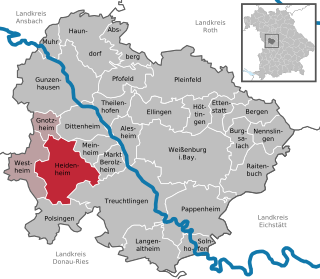
Albert III was Elector of Brandenburg from 1471 until his death, the third from the House of Hohenzollern. A member of the Order of the Swan, he received the cognomen Achilles because of his knightly qualities and virtues. He also ruled in the Franconian principalities of Ansbach from 1440 and Kulmbach from 1464.

Neustadt an der Aisch is a small town of around 12,000 in the northern part of Bavaria (Germany), within the Franconian administrative region Middle Franconia. It is the district town of the district Neustadt (Aisch)-Bad Windsheim.

The Principality or Margraviate of (Brandenburg-)Ansbach was a free imperial principality in the Holy Roman Empire centered on the Franconian city of Ansbach. The ruling Hohenzollern princes of the land were known as margraves, as the principality was a margraviate.

The Principality of Bayreuth or Margraviate of Brandenburg-Bayreuth was an immediate territory of the Holy Roman Empire, ruled by a Franconian branch of the Hohenzollern dynasty. Since Burgrave Frederick VI of Nuremberg was enfeoffed with the Margraviate of Brandenburg in 1415/17, the Hohenzollern princes transferred the margravial title to their Franconian possessions, though the principality never had been a march. Until 1604 they used Plassenburg Castle in Kulmbach as their residence, hence their territory was officially called the Principality of Kulmbach or Margraviate of Brandenburg-Kulmbach until the Empire's dissolution in 1806.

The Prince-Bishopric of Eichstätt was a small ecclesiastical principality of the Holy Roman Empire. Centered on the town of Eichstätt, it was located in the present-day state of Bavaria, somewhat to the west of Regensburg, to the north of Neuburg an der Donau and Ingolstadt, to the south of Nuremberg, and to the southeast of Ansbach.

Heilsbronn is a town in the Ansbach district of the Mittelfranken administrative region of Franconia, in the German state of Bavaria between Nuremberg and Ansbach, in the wooded valley of the Rangau. Its hallmark is the Katharinenturm, a medieval tower.

Herrieden is a town in the district of Ansbach and situated in the Middle Franconia region of Bavaria, Germany. It lies along the upper Altmühl river, about 9 km (6 mi) southwest of the city of Ansbach, 47 km southwest of the city of Nürnberg, 95 km east of Heilbronn and 144 km northwest of Munich. It is part of a cooperative with the nearby small cities of Aurach, Burgoberbach, and Leutershausen. Herrieden is located close to the A6 autobahn between Nürnberg and Heilbronn. Herrieden is administratively over the large towns of Neunstetten to the north, Rauenzell to the east and Elbersroth to the southwest. Other towns and villages administratively under Herrieden include Birkach, Bittelhof, Böckau, Brünst, Buschhof, Esbach, Gimpertshausen, Gräbenwinden, Heuberg, Höfstetten, Hohenberg, Lammelbach, Lattenbuch, Leibelbach, Leuckersdorf, Leutenbuch, Limbach, Manndorf, Mühlbruck, Niederdombach, Oberschönbronn, Regmannsdorf, Rös, Roth, Sauerbach, Schernberg, Schönau, Seebronn, Sickersdorf, Stadel, Stegbruck, Steinbach, Velden and Winn.

Merkendorf is a municipality in the district of Ansbach, in Bavaria, Germany. It is situated 14 km southeast of Ansbach.

Schillingsfürst is a municipality in the district of Ansbach, in Bavaria, Germany. It is situated 12 km southeast of Rothenburg ob der Tauber, and 23 km west of Ansbach.

Wolframs-Eschenbach is a town in the district of Ansbach, in Bavaria, Germany. It is situated 14 km southeast of Ansbach, and 36 km southwest of Nuremberg.

Lichtenau is a market town in the district of Ansbach, Mittelfranken, Bavaria, Germany.

Christian Frederick Charles Alexander was the last Margrave of the two Franconian principalities, Brandenburg-Ansbach and Brandenburg-Bayreuth, which he sold to the King of Prussia, a fellow member of the House of Hohenzollern.

Wörnitz is a municipality in the district of Ansbach, in Bavaria, Germany. It is situated on the river Wörnitz, west of Ansbach.

Heidenheim is a municipality in the Weißenburg-Gunzenhausen district, in Bavaria, Germany.

Weidenbach is a municipality in the district of Rhein-Lahn, in Rhineland-Palatinate, in western Germany. Its municipal council consists of six members elected by majority vote, and headed by the honorary mayor, or chairman.

Weidenbach is an Ortsgemeinde – a municipality belonging to a Verbandsgemeinde, a kind of collective municipality – in the Vulkaneifel district in Rhineland-Palatinate, Germany. It belongs to the Verbandsgemeinde of Daun, whose seat is in the like-named town. In Weidenbach, a Moselle Franconian dialect is spoken.

Weidenhahn is an Ortsgemeinde – a community belonging to a Verbandsgemeinde – in the Westerwaldkreis in Rhineland-Palatinate, Germany.

The Wolf of Ansbach was a man-eating wolf that attacked and killed an unknown number of people in the Principality of Ansbach in 1685, then a part of the Holy Roman Empire.

Sophia of Poland, was a princess, member of the Jagiellonian dynasty, great grand daughter of Emperor Sigismund and by marriage Margravine of Brandenburg-Ansbach and Brandenburg-Kulmbach.
























